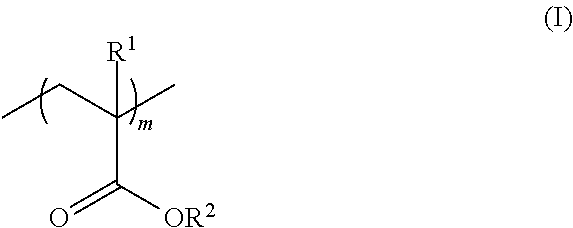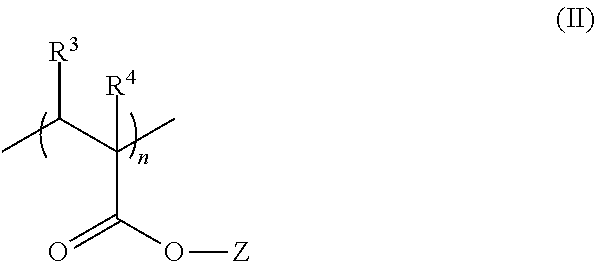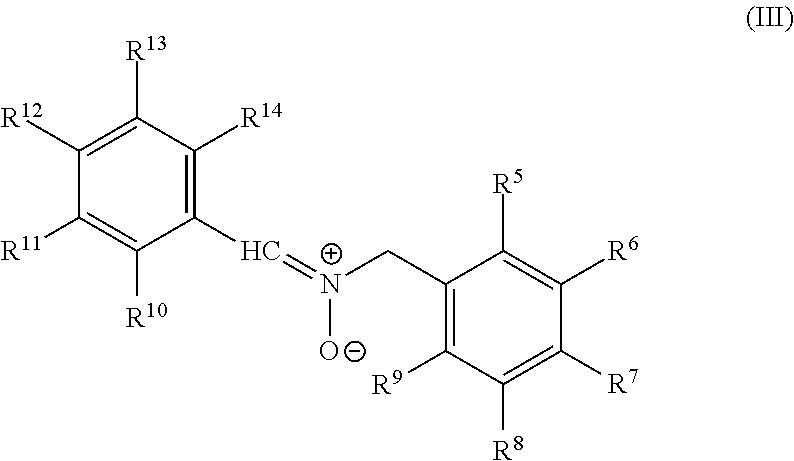Polymeric nitrones and their use in personal care
a technology of polymer nitrones and nitrones, which is applied in the field of polymer nitrones and their use in personal care, can solve the problems that the performance of nitrones cannot be achieved, and achieve the effects of less oxidative damage, higher efficacy, and equal efficacy
- Summary
- Abstract
- Description
- Claims
- Application Information
AI Technical Summary
Benefits of technology
Problems solved by technology
Method used
Image
Examples
example 1
Synthesis of Polyacrylate Polymer Substrate: Polymethyl Acrylate—Maleic Anhydride Copolymer (PMA-c-MAnh)
[0055]A 100 mL 1-neck flask was equipped with a stir bar and a 3-way stopcock. Methyl acrylate (MA, 9.56 grams, 0.111 moles) and maleic anhydride (MAnh, 3.3 grams, 0.0337 moles) were dissolved in the flask in 50 mL of ethyl acetate. The flask was purged with nitrogen, sealed, and cooled in a dry ice / isopropanol bath. After freezing, the flask was placed under vacuum, re-sealed, and then allowed to warm to room temperature. This process was repeated 4 additional times. The purged monomer solution was combined with 0.46 grams of 2,2′-azobis(2-methylpropionitrile) (AIBN). The flask was again sealed, and then heated to 50° C. for 18 hours. Gel permeation chromatography showed the presence of a trace of MAnh to be present. The polymer solution volume obtained was 63.8 mL, which had a MA content of 0.111 moles (1.74 mmoles / mL) and a MAnh content of 0.0337 moles (0.528 mmoles / ML).
Synthes...
example 2
Synthesis of Polyacrylate Polymer Substrate: Polydiethyleneglycol Methyl Ether Acrylate—Acryloyl Chloride Copolymer (PAC-c-DEGMEA)
[0057]Freshly distilled acryloyl chloride (AC, 11.4 grams, 0.126 moles) was mixed with 25 mL of inhibitor-free anhydrous tetrahydrofuran (THF) in a flask. The flask was purged with nitrogen, sealed, and cooled in a dry ice / isopropanol bath. After freezing, the flask was placed under vacuum, re-sealed, and then allowed to warm to room temperature. This process was repeated 4 additional times. The purged monomer solution was combined with 0.48 grams of 2,2′-azobis(2-methylpropionitrile) (AIBN), and the mixture was heated at 50° C. overnight to result in a solution containing 3.5M polyacryloyl chloride (PAC) in THF (3.5 mmoles / mL).
[0058]The polyacryloyl chloride—diethyleneglycol methyl ether acrylate copolymer was prepared according to the procedure described in W. Zou, et al., Polymer International, 60(5), 751 (2011). A 1.0 mL aliquot of the above PAC solut...
example 3
Antioxidant Potential
[0060]Antioxidant potential is evaluated using the Oxygen Radical Absorbance Capacity (ORAC) protocol. ORAC is a chemical in-vitro method based on the hydrogen atom transfer (HAT) mechanism (see N. Re et al., Free Radical Biology &Medicine, 26 (9 / 10), 1231 (1997)). ORAC measures antioxidant inhibition of peroxyl radical induced oxidations and thus reflects classical radical chain breaking antioxidant activity by H atom transfer. In this assay, the peroxyl radical reacts with a fluorescent probe to form a non-fluorescent product. This is quantitated using a fluorescence measurement. Antioxidant capacity is determined by decreased rate and amount of product formed over time. This assay depends upon the free radical damage to the fluorescent probe resulting in the change in its fluorescence intensity. The change of fluorescence intensity is an indicator of the degree of free radical damage. In the presence of an antioxidant, the inhibition of free radical damage is...
PUM
| Property | Measurement | Unit |
|---|---|---|
| temperature | aaaaa | aaaaa |
| volume | aaaaa | aaaaa |
| temperature | aaaaa | aaaaa |
Abstract
Description
Claims
Application Information
 Login to View More
Login to View More - R&D
- Intellectual Property
- Life Sciences
- Materials
- Tech Scout
- Unparalleled Data Quality
- Higher Quality Content
- 60% Fewer Hallucinations
Browse by: Latest US Patents, China's latest patents, Technical Efficacy Thesaurus, Application Domain, Technology Topic, Popular Technical Reports.
© 2025 PatSnap. All rights reserved.Legal|Privacy policy|Modern Slavery Act Transparency Statement|Sitemap|About US| Contact US: help@patsnap.com



